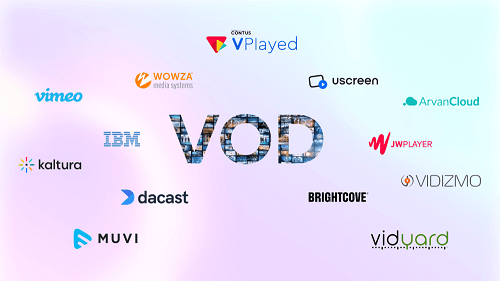What is VOD, and Why Should Content Providers Create One in 2023?

OTT/IPTV video streaming services have multiple features that simplify life for viewers and companies. One of the functions customers appreciate is video-on-demand or VOD.
VOD is a video streaming solution and distribution platform that delivers content via the Internet. Videos are stored on servers and transmitted to viewers after a request is made. VOD allows users to watch content where and when they want.
Let’s talk more about VOD.
What are the Advantages of VOD?
VOD platforms have four main benefits:
- Available at any time. You can create a streaming app to allow viewers to watch videos whenever they want. In comparison with traditional television, which streams programs in real-time, VOD doesn’t have a fixed schedule.
- Available on any device. Content providers usually allow users to access videos on any device, including smartphones, tablets, and Smart TVs.
- Diverse content. VOD content creators produce unique and engaging videos. Having plenty of content at their disposal allows viewers to find programs according to their interests.
- Control. A video streaming solution usually has features for people to control how they consume content. These features include play, pause, rewind, and fast forward.
To sum up, VOD gives viewers the opportunity to decide how, when, and where they consume content. They are in charge of the whole process.
What are the Benefits of VOD for a Business?
#1 Monetization
VOD platforms help businesses generate more revenue. Due to the high demand for content available at any time among viewers, video streaming platforms are on the rise.
VOD services have a monetization potential. Content providers can use the following models to make money:
- AVOD or Advertising-based Video-On-Demand. Money is earned by advertising. A provider runs ads on their videos, and viewers can watch content without a fee due to this.
- SVOD or Subscription-based Video-On-Demand. A subscription allows a viewer to purchase monthly or annual access to video content on the platform. When the paid period ends, people can renew or cancel their subscriptions.
- TVOD or Transactional-based Video-On-Demand. In comparison with a subscription that offers unlimited access to videos, TVOD allows viewers to purchase every video on the platform.
- The hybrid monetization model is a combination of two or three models described above. For example, a provider creates a group of videos available on a subscription basis and Premium content that requires additional payment. It is SVOD and TVOD combined.
#2 People are switching to video streaming services
There are two factors a business should keep in mind:
- People usually prefer videos over other content. They consider it more informative and engaging compared to other types of content, like podcasts or texts. Videos are becoming more important among viewers. They look for videos to entertain, understand the product or service better and learn.
- A video streaming service costs less than cable and satellite television. While cable or satellite can cost more than $200, the video streaming service costs around $10-$20 per month.
All these reasons explain why people are switching to online streaming services.
Summing Up
VOD platforms operate via the Internet, which brings many benefits to companies and consumers. These platforms offer viewers the ability to control how, when, and where they consume video content. Businesses, in turn, generate more revenue with the help of video streaming platforms.
If you want to create a video streaming platform, we recommend you contact Setplex. The company can offer you a solution to achieve business goals.








